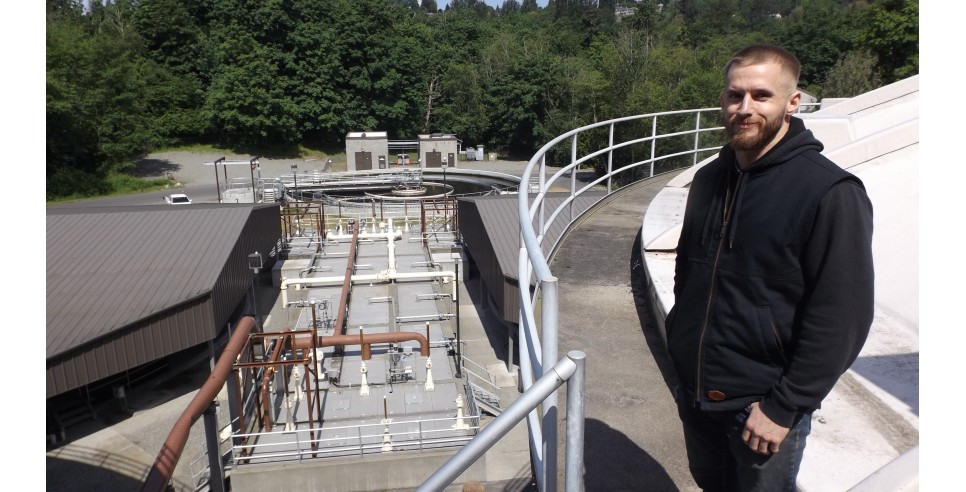
Thirteen years ago this month, Bryan Asplund had just graduated from high school and gotten a summer job as the groundskeeper at the local wastewater treatment plant. It was a 90-day contract – a chance for him to bring in some cash over the summer while he figured out what he wanted to do with his life. That June, July and August, he mowed the lawn, weeded and swept, and lent a hand whenever needed.
The other guys at the plant noticed that he was “handy with a wrench” – he’d grown up working in his dad’s garage. And he’d become a state certified welder before the age of 18, so clearly he was a self-starter.
When Asplund’s contract was up in September, he was hired on as part of the permanent crew. More than a decade later, he’s still with the Midway Sewer District, where he now serves as Operations Supervisor at the Des Moines Creek Wastewater Treatment Plant.
The District is located a short distance south of Seattle. In 1946, residents of what was then the small waterside community of Des Moines (WA), petitioned their county government to form a sewer district that would serve about 200 acres. But it wasn’t until a decade later that voters finally approved funding for a Comprehensive Scheme of Sewers, and the system finally became operational at the very end of 1958.
In the early 1960s, the area south of Seattle experienced a population boom. New developments with names like Thunderbird Estates, Crest View, and Sweptwing all wanted in on the system, and so the District grew.
Today the Midway Sewer District encompasses about 10 square miles, bounded on the north by SeaTac International Airport (the nation’s eighth busiest hub for air traffic), on the east by I-5 and on the west by Puget Sound. Parts of five different cities lie within the District’s service area, along with a college campus, a marina and a state park. And the area’s population only continues to grow – meaning more dishes to wash, more showers to take, more toilets to flush and – because of proximity to the airport, more influent from airport-related industries as well.
Most of us probably don’t think much about where our wastewater goes once it swirls down the drain. In fact, most of us would rather not think about that at all.
The Midway Sewer District maintains a discreet presence in the community. Its 13 pump stations throughout the District are located in low-profile buildings behind chain link fences. And the wastewater treatment plant itself is located in a wooded ravine, largely out of view from the public eye, if not the public nose. The plant’s carbon odor scrubbers actually help to keep that in check, but earlier this month, when Asplund took this writer on a tour of the facility where he works, he acknowledged that his line of work does require a certain amount of olfactory adaptation.
We began the tour by climbing the steps up to the top of a massive trickling filter tower to get an overview of the entire plant. Asplund swept his arm out to indicate the complex assortment of buildings where different steps in the wastewater treatment process take place.
“This is a giant machine that needs constant maintenance,” he said. “I’ve worked on and fixed so many things around this whole place. It’s a living resume for me.”
He pointed out the headworks, where incoming wastewater, called influent, comes in and passes through perforated screens that separate out the “rags” – feminine products, plastic bags, and – the scourge of wastewater treatment plants everywhere – “flushable” wipes.
“Just because you “can” flush them, doesn’t mean you should flush them,” Asplund said, and his co-workers reiterated this as we moved on through the tour. Ask any wastewater treatment worker anywhere – disposable wipes have a reputation for gumming up the works and necessitating costly repairs. Wipes should never be flushed.
Next on the tour we stopped to take a look at the clarifiers – long rectangular tanks that slow the flow of sewage enough to allow primary sludge to settle to the bottom while fats, oils and greases, called FOG or scum, float to the top. These tanks were open to the air, but covered by a shed roof, and as we leaned over the railing to look down at the murky fluid that was passing through, we could see that the surface was dotted with thousands of yellow bits of coagulated fat.
At the end of this process, the FOG is collected in a tank. Asplund pried open the lid of the tank to show the end result: a large yellow block of compressed fat. But why were there occasional fragments of green and purple embedded in that oily block? Asplund conceded that those perforated screens we’d seen at the beginning of the process hadn’t been able to separate out 100% of the “rags” that people flushed down their toilets.
We moved on to the next step in the process. An anaerobic digester on the grounds converts some of these waste byproducts into methane, which runs the plant’s boilers. We descended into subterranean rooms that roared with the sound of machinery at work, then went back outside and climbed to the top of another trickling filter tower to peek through a doorway. Inside the tower, a vast mass of honeycombed media provides a “bug farm” that assists with further filtration of the water in the purifying process.
Back down at ground level, Asplund dipped out a bucketful of water that had gone through the whole treatment process and was about to be conveyed underground and released through an underwater pipe that extends more than a quarter mile into the depths of Puget Sound.
Throughout the tour, I scribbled down notes about googly mass biofilm, biochemical oxygen demand (BOD), inflow and infiltration (I & I) and anaerobic digesters. But, with a sinking feeling, I realized that I wasn’t going to be able to comprehend half of what I’d written down by the time I got back to my desk to write up this story.
One of the most important takeaways for me, though, was the story of this young man’s successful career and the satisfaction he derives in working with his colleagues.
“I love working here,” Asplund said. “It’s the kind of job where you wake up on Monday and don’t dread going to work. There’s no typical day.”
While many other sewer districts hire external contractors to come in to perform mechanical rebuilds, this plant’s small crew of workers has the skills to fabricate metal, rebuild pumps and repair bearings. While a college degree isn’t required for many of the positions on the crew, mechanical aptitude is a must, and with evolving changes on the regulatory front and new advances in technology, workers need to take continuing credits and pass tests to keep their operator’s license up to date.
Also required: strategic planning skills. While the influent will never stop coming, workers have to be able to divert or retain flow in order to repair equipment or respond to environmental conditions. This requires careful mathematical calculations and often requires that the work be done in the wee hours of the morning, when fewer households and businesses are dumping into the system.
The wastewater management field offers good careers for blue collar workers but, as in other industries, there is concern that as people retire out of those jobs, there won’t be enough young workers to replace them.
While the work they perform may go unnoticed by most people, Asplund and his colleagues know how vital their work is to the community.
“I’m proud of the work we do,” Asplund said. “We’re stewards of public health.”
Barbara Lloyd McMichael is a freelance writer living in the Pacific Northwest.









